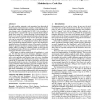Free Online Productivity Tools
i2Speak
i2Symbol
i2OCR
iTex2Img
iWeb2Print
iWeb2Shot
i2Type
iPdf2Split
iPdf2Merge
i2Bopomofo
i2Arabic
i2Style
i2Image
i2PDF
iLatex2Rtf
Sci2ools
POPL
2009
ACM
2009
ACM
Modular code generation from synchronous block diagrams: modularity vs. code size
We study modular, automatic code generation from hierarchical block diagrams with synchronous semantics. Such diagrams are the fundamental model behind widespread tools in the embedded software domain, such as Simulink and SCADE. Code is modular in the sense that it is generated for a given composite block independently from context (i.e., without knowing in which diagrams the block is to be used) and using minimal information about the internals of the block. In previous work, we have shown how modular code can be generated by computing a set of interface functions for each block and a set of dependencies between these functions that is exported along with the interface. We have also introduced a quantified notion of modularity in terms of the number of interface functions generated per block, and showed how to minimize this number, which is essential for scalability. Finally, we have exposed the fundamental trade-off between modularity and reusability (set of diagrams the block can ...
Hierarchical Block Diagrams | Maximal Reusability | Modularity Vs | POPL 2009 | Programming Languages |
| Added | 22 Nov 2009 |
| Updated | 22 Nov 2009 |
| Type | Conference |
| Year | 2009 |
| Where | POPL |
| Authors | Roberto Lublinerman, Christian Szegedy, Stavros Tripakis |
Comments (0)

